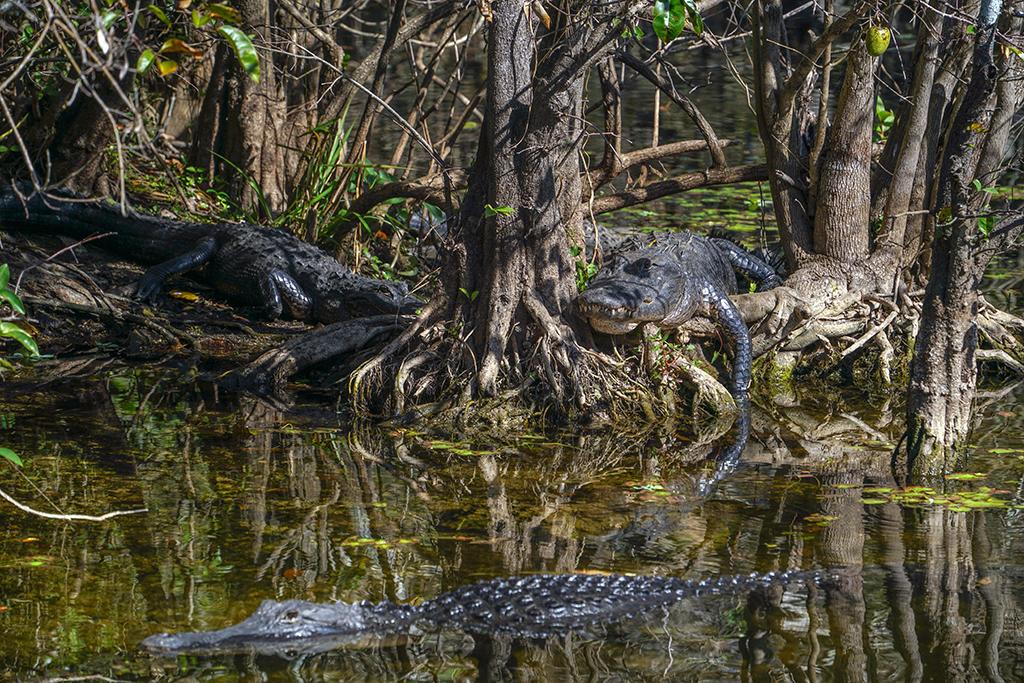You might think of Big Cypress National Preserve in Florida as Everglades National Park’s “kid sister,” but there’s just as much wildlife to be seen in this national preserve, home to Florida’s largest reptile, the American alligator, as well as the endangered Florida panther. Big Cypress is a birder’s paradise, so don’t forget your binoculars or camera for spotting any of the 190 species of birds calling this place home or just passing through for a spell.

You *might* spot a black bear doing something crazy during your visit to Big Cypress National Preserve / NPS file
What might you see while touring around Big Cypress? The most common wildlife sightings will be turtles, alligators, frogs, squirrels, and birds, depending upon your location. Of the mammals, the most common sight will probably be the Big Cypress fox squirrel. If you are patient and observant, and happen to be in the right place at the right time, you might spot a black bear, manatee, or, if you are very lucky, an endangered Florida panther.

The feline beauty of an endangered Florida panther at Big Cypress National Preserve / Ralph Arwood Collection #23 via NPS
A subspecies of the mountain lion, Florida panther populations are endangered due to habitat loss / fragmentation of their habitat, feline leukemia virus, and careless drivers. According to a 2024 Traveler article, of the 33 documented deaths of this big cat for that year, 26 were from vehicle collisions.
While not endangered, the Florida manatee is listed as threatened due to poor fishing practices, boat collisions, habitat loss, and pollution. Your best chance at spotting a manatee is around the rivers, estuaries, and coastal areas within Big Cypress. You can learn more about the manatee by listening to the Traveler’s Podcast Episode 286.

American alligators, Big Cypress National Preserve / NPS via Flickr
Visit the marshes, swamps, freshwater lakes, slow-moving rivers, and the canals within Big Cypress and it’s almost a guarantee you will see an American alligator. These armored reptiles can sometimes grow as long as 15 feet (4.6 m)! Best to look at an alligator with your binoculars or telephoto lens, because getting too close will earn you a hiss, deep rumble, and an open jaw displaying rows of sharp teeth. Because of their size and bulk, alligators may look slow, but they can unexpectedly lunge with a speed up to 30 miles per hour (48.3 kph).
Birds

An egret in the watery marsh an Big Cypress National Preserve / NPS via Flickr
Featured On The Traveler
There aren’t many locations within the National Park System where bird-watching is easier than in Big Cypress National Preserve. It’s even possible to see a lot of birds (and alligators) while careening down the highway at 55 mph. (We, of course, don’t recommend careening anywhere where an endangered Florida Panther might cross your path.)
To read more of this article, head over to this page.
Photographing The Wildlife

On occasion, a bird like the wood stork at Big Cypress National Preserve will stand still long enough to pose for your camera / NPS via Flickr
Birds and wildlife in general are not ones to pose for the camera – at least, not for very long. If you plan to photograph any wildlife in this national preserve, you’ll want to have two things: a fast camera and a telephoto lens (the longer the focal length, the better). Sure, you can utilize the telephoto setting on your smartphone, but for a sharp, detailed image, an SLR or even a point-and-shoot are your best bets.
A “fast” camera is one with a large fps (frames per second) rate. Usually that’s in the realm of 20- to 30 fps. You want a camera with those fast shutter clicks because you’ll be holding down on the shutter button while aiming that telephoto lens toward your subject. This is called the “burst method,” and out of all those shots you get from this method of capturing the wildlife, at least one (probably more) will be sharp and clear, having frozen your subject’s movement. The only caveat is the burst method uses a lot of memory card space, so you’ll need to carry spare cards with you for a day of photography at Big Cypress.
A telephoto lens brings you up close and personal to the wildlife without moving too near and scaring it away. A “long lens” is another name for a telephoto lens. A large, or long, focal length means you have a lens with plenty of close-up power. This can range from a lens with 100-400mm focal length all the way up to an 800mm lens!
These cameras and telephoto lenses are not cheap, by any means. However, you can rent either or both at a fraction of the retail price by going to any of a number of online rental sites like lensrentals.com, lensprotogo.com, or rentglass.com, to name a few.
Always drive the posted speed limits within this and other units of the National Park System. Wildlife tends not to obey traffic signs or rules. If you read the Traveler article mentioned earlier, you’ll know that vehicle collisions are a big factor in Florida panther deaths.
While you are at it, don’t feed or get too close to the wildlife, either. Habituation makes them aggressive toward humans, and human food is not good for their digestive systems, not to mention it’s not a naturally-occurring food source for them.

Ssssstay back! Diamondback rattlesnake, Big Cypress National Preserve / NPS via Flickr





